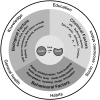Erosion--diagnosis and risk factors
- PMID: 18228059
- PMCID: PMC2238777
- DOI: 10.1007/s00784-007-0179-z
Erosion--diagnosis and risk factors
Abstract
Dental erosion is a multifactorial condition: The interplay of chemical, biological and behavioural factors is crucial and helps explain why some individuals exhibit more erosion than others. The erosive potential of erosive agents like acidic drinks or foodstuffs depends on chemical factors, e.g. pH, titratable acidity, mineral content, clearance on tooth surface and on its calcium-chelation properties. Biological factors such as saliva, acquired pellicle, tooth structure and positioning in relation to soft tissues and tongue are related to the pathogenesis of dental erosion. Furthermore, behavioural factors like eating and drinking habits, regular exercise with dehydration and decrease of salivary flow, excessive oral hygiene and, on the other side, an unhealthy lifestyle, e.g. chronic alcoholism, are predisposing factors for dental erosion. There is some evidence that dental erosion is growing steadily. To prevent further progression, it is important to detect this condition as early as possible. Dentists have to know the clinical appearance and possible signs of progression of erosive lesions and their causes such that adequate preventive and, if necessary, therapeutic measures can be initiated. The clinical examination has to be done systematically, and a comprehensive case history should be undertaken such that all risk factors will be revealed.
Figures





References
-
- {'text': '', 'ref_index': 1, 'ids': [{'type': 'PubMed', 'value': '11759103', 'is_inner': True, 'url': 'https://pubmed.ncbi.nlm.nih.gov/11759103/'}]}
- Al-Malik MI, Holt RD, Bedi R (2001) The relationship between erosion, caries and rampant caries and dietary habits in preschool children in Saudi Arabia. Int J Paediatr Dent 11:430–439 - PubMed
-
- {'text': '', 'ref_index': 1, 'ids': [{'type': 'PubMed', 'value': '11472810', 'is_inner': True, 'url': 'https://pubmed.ncbi.nlm.nih.gov/11472810/'}]}
- Amaechi BT, Higham SM (2001) In vitro remineralisation of eroded enamel lesions by saliva. J Dent 29:371–376 - PubMed
-
- {'text': '', 'ref_index': 1, 'ids': [{'type': 'PubMed', 'value': '9701659', 'is_inner': True, 'url': 'https://pubmed.ncbi.nlm.nih.gov/9701659/'}]}
- Attin T, Zirkel C, Hellwig E (1998) Brushing abrasion of eroded dentin after application of sodium fluoride solutions. Caries Res 32:344–350 - PubMed
-
- {'text': '', 'ref_index': 1, 'ids': [{'type': 'PubMed', 'value': '9892781', 'is_inner': True, 'url': 'https://pubmed.ncbi.nlm.nih.gov/9892781/'}]}
- Attin T, Dreifuss H, Hellwig E (1999) Influence of acidified fluoride gel on abrasion resistance of eroded enamel. Caries Res 33:135–139 - PubMed
-
- {'text': '', 'ref_index': 1, 'ids': [{'type': 'PubMed', 'value': '11385203', 'is_inner': True, 'url': 'https://pubmed.ncbi.nlm.nih.gov/11385203/'}]}
- Attin T, Knöfel S, Buchalla W, Tütüncü R (2001) In situ evaluation of different remineralisation periods to decrease brushing abrasion of demineralized enamel. Caries Res 35:216–222 - PubMed

